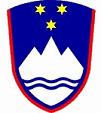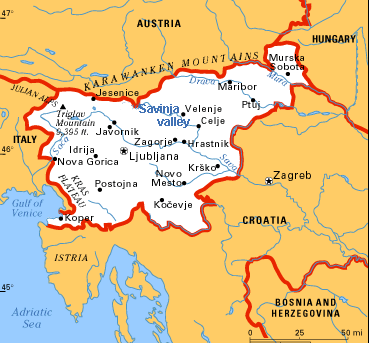 SLOVENIA
- 30 years on
SLOVENIA
- 30 years on
This week's Photos Bottom of page
Return to Index-page
|
However much
we had enjoyed our 3 days in Ljubljana, it was a good feeling to be
heading out to more rural parts of the country. The first stage of our
journey took us north-eastwards, to spend the week along the valley of the
River Savinja, from its source high up in the Kamniske-Savinska Alps near
the Austrian border, through the broad flat planes of the middle valley,
down to the sluggishly muddy river at its confluence with the longer Sava
River, just beyond the town of Celje. We moved on over the high summer pastures of the Velika Planina, and down into the valley of the Savinja river, our 'home' for the next week, camping first at Avtocamp Šmica on the banks of the river (Photo 4). It was a beautiful valley, dotted with flower-decked Alpine chalet-style farmsteads, with wooded hills rising steeply on both sides, rising to jagged peaks on the skyline. The nearby village of Luče met our provisions needs with its well-stocked Mercatur mini-market, even having free internet facilities in the small knjižnica (library) and of course several gostilna (inns) for early evening beer. We explored the higher valley of Logarska dolina, where the views along richly green meadows of the classic flat-bottomed glacial valley were breathtaking (Photo 2). At the top of the valley, we climbed up to the 100 feet high Slap Rinka waterfall, just below the source of the Savinja, and for the next week, we followed the river for its whole length down to where it merged with the Sava. Although wild flowers at this time of year are not so spectacular as in Spring, we have seen more than enough to keep Sheila busy, particularly in the higher Alpine areas (Photo 3). After a couple of peaceful days, this delightful camping spot was invaded by Dutch - they're lovely people, but they do hunt in packs and make an inordinate amount of noise. Experience suggests that, because Holland is so low-lying, only 10% of the population are allowed to be there at any one time, to prevent the country sinking back into the North Sea. The rest seem to swarm noisily across Europe in large groups - so where on earth do you go in August to find peace from the ubiquitous Dutch? Rumour has it that when Neil Armstrong stepped down from the LEM ladder onto the Moon's surface with his famous "One small step for man ...", his actual words, censored by NASA, were "Oh my God, there are 4 Dutch caravans here already". Be that as it may, the noise from swarming Dutch became just too much, and we moved on down to the middle part of the Savinja valley near to the town of Možirje, seeking peace. Fortunately, we found a quiet leafy oasis at Camping Savinja which we made our base for the next few days. Up in the nearby village of Spodnje, we found a superb bar where the rowdy banter rivalled the atmosphere of the 'Coach and Horses' - the beer was good too, and we learnt another important Slovenian phrase 'Na zdravj' (cheers). Just over into the neighbouring valley, the town of Velenje has another claim to fame - coal - which has been mined in Velenje since the 18th century. Lignite is now mined on a massive industrial scale to feed the enormous power station which meets most of Slovenia's electrical requirements. A section of the mine is open to visitors as the Slovenian Coalmining Museum - that we could not miss. Equipped with pit jackets and hard-hats, we descended the 180 m shaft and were shown older and modern workings, including a simulated underground explosion and roof collapse to demonstrate the dangers faced by miners. It was a thoroughly fascinating experience. While in Velenje, we had also to see something of the town that was founded in 1959, as the Socialist version of Milton Keynes (and marginally more aesthetic), planned as a model industrial workers' town with drab high-rise appartments, wide streets and open squares. The then Yugoslav president, Tito, even brought Breznev here to impress the dour Soviet leader with what enlightened Communism, Tito-style, could achieve. By the central square, Titov trg, devoid of any charm, stood a grossly over-large statue of the Yugoslav president. In the modern world of market economy affluent and independent Slovenia, it all seemed quaintly anachronistic. The massive Gorenje household appliance factory complex on the outskirts, the main source of employment, now seemed a far more relevant symbol of the town's evident affluence. We moved on to the lower Savinja valley, to camp near Slovenia's 3rd largest city, Celje (pronounced 'Tselyeh'). There were a number of places of interest in this area, including an archaeological site (can't get away from them!) from Celeia, Celje's Celtic- Romano predecessor, and an impressive show-cave, the Jama Prekel, with subterranean waterfall. Of far greater interest however was the area's main claim to fame, as evidenced by the extensive hop fields along the lower Savinja, - yes, brewing. The small town of Laško, 12 kms south of Celje and a similar distance from the river's confluence with the Sava, is dominated by the mighty Laško Pivovarna (brewery - another useful Slovenian word learnt), founded in 1825 and, along with the Union brewery in Ljubljana, one of the largest in the country. Visits to the brewery were not a regular feature, but given our liking for Zlatorog pivo (named after the legendary giant mountain goat), we had to try. The campsite owner, Tomaž Vozlič was a formidable character, so we put him onto the job. In his most commanding manner, it was all fixed: a special visit for 'his guests' was agreed, and we should report to the brewery's Head Scientist, Regina Godec, at 12-00 noon. We were received like VIPs by Ms Godec and given a personal tour of the enormous industrial scale, fully automated and computer-controlled brewing and bottling plants. And of course afterwards, we received similar hospitality in the sampling room, which gave us chance to discuss with her so many of the questions bothering us about life in modern Slovenia compared with pre-independence Yugoslavian federation. Inevitably this gave something of a different slant on winners (few) and losers (many) from the switch from state control to market economy. Our time in the Savinja valley concluded with seeing the river's final stage, as muddy and sluggish at this point, it flowed into the bigger Sava river at Zidani Most, an important railway junction, connecting to Zagreb in Croatia, which sowed the seeds of an idea for a journey by train we might make later in the trip. We now move on further north to the region of Koroška bordering on Austria, then to the furthest eastern corner of Prekmurje - coming next on this channel. Sheila and Paul Published: 12 August 2004
|

